Fakhredin Blog
The posts in this weblog are mainly about history, heritage, language, art, and culture of Persia (that is named Iran since 1934). Persia is, therefore, equal to Iran, and Persian is equal to Iranian. Note that Persian is a nationality not an ethnicity. Pars (or Fars) is the major ethnicity in Persia but there are also Persian Kurds or Arabs. Similarly, the official language in Persia is Persian (Farsi is the local name and may not be used internationally). For more details please read my posts.
Tuesday, August 29, 2006
Beauties of Persia: The wind-towers of Yazd
 You know about wind-towers of Yazd, don't you? O! maybe not! Yazd is a city in the center of Persia, which is located in the center of desert. Old architecture of Yazd is really wonderful. The old houses, in this warm and dry place, are staying cool with use of no energy but the wind and the wind-towers.
You know about wind-towers of Yazd, don't you? O! maybe not! Yazd is a city in the center of Persia, which is located in the center of desert. Old architecture of Yazd is really wonderful. The old houses, in this warm and dry place, are staying cool with use of no energy but the wind and the wind-towers.
A Persian-French architect couple, Shiva Tolouie and Harvé Richard, have used their scholarship of outstanding architects to travel to Yazd and do a research about the wind-towers of this city. They have already presented their research in some exhibitions, but, according to their website, another exhibition will open in Paris from 20 September until 29 October 2006. If you like, have a look at the website about their research "Yazd, the wind-towers" (it is in Frech, though). You may also like to look at the website of Yazd city.
An article is published in CyberArchi about Shiva and Harvé, but again the article is in French. There, you can also find a beautiful collection of photos from the wind-towers of Yazd. Since the full text of the article may not be accessable later on the net, I copy the text here. If you can translated it to English, please contact me, and I put your translation on the blog.
Next time, I write for you about one of the other beauties of Persia: The longest water-cave in the world, Alisadr Cave.
* Also available in Persian language
 You know about wind-towers of Yazd, don't you? O! maybe not! Yazd is a city in the center of Persia, which is located in the center of desert. Old architecture of Yazd is really wonderful. The old houses, in this warm and dry place, are staying cool with use of no energy but the wind and the wind-towers.
You know about wind-towers of Yazd, don't you? O! maybe not! Yazd is a city in the center of Persia, which is located in the center of desert. Old architecture of Yazd is really wonderful. The old houses, in this warm and dry place, are staying cool with use of no energy but the wind and the wind-towers.A Persian-French architect couple, Shiva Tolouie and Harvé Richard, have used their scholarship of outstanding architects to travel to Yazd and do a research about the wind-towers of this city. They have already presented their research in some exhibitions, but, according to their website, another exhibition will open in Paris from 20 September until 29 October 2006. If you like, have a look at the website about their research "Yazd, the wind-towers" (it is in Frech, though). You may also like to look at the website of Yazd city.
An article is published in CyberArchi about Shiva and Harvé, but again the article is in French. There, you can also find a beautiful collection of photos from the wind-towers of Yazd. Since the full text of the article may not be accessable later on the net, I copy the text here. If you can translated it to English, please contact me, and I put your translation on the blog.
Next time, I write for you about one of the other beauties of Persia: The longest water-cave in the world, Alisadr Cave.
| Les tours des vents de Yazd (Iran) revisitées par Hervé Richard et Shiva Tolouie |
| Les architectes Hervé Richard (né en 1974) et Shiva Tolouie (née en 1973) sont fascinés par le rapport entre l’architecture et la nature. Ils font partie des lauréats de la Bourse EDF aux jeunes architectes cession 2004-2006. Cette bourse qui finance un voyage à l’étranger leur a permis d’aller étudier sur place les tours des vents de la ville de Yazd en Iran. Découverte. |
| Les maisons traditionnelles de cette région aride et chaude sont rafraîchies par ces tours sans autre énergie que celle du vent. Le résultat de leur étude (à suivre sur www.richard-tolouie.com), est actuellement présenté à l’exposition Alter Architecture (Fondation pour l’Architecture de Bruxelles jusqu’au 26 mars 2006) avant d’être présenté à l’Espace Electra de Paris à partir du mois de juin. Le texte ci-dessous est signé Hervé Richard et Shiva Tolouie  La ville de Yazd se trouve sur le haut plateau du centre de l’Iran, entourée par le désert, à proximité de montagnes dépassant 4000m d’altitude. Cette région connaît un climat particulièrement extrême : écrasée de chaleur en été alors qu’il y gèle en hiver, il n’y tombe pratiquement aucune pluie et les vents qui y soufflent sont chargés de sable du désert. Les habitants de cette ville ont dû composer avec les éléments pour façonner leur milieu. Ils ont pu rendre accueillante cette région inhospitalière en canalisant l’eau depuis les montagnes, en donnant forme à la terre, en rendant fertile le sable, en se protégeant de la chaleur trop ardente. L’exemple le plus original de cette adaptation se trouve certainement dans les tours des vents qui se sont développées dans cette ville d’une manière unique. Les badgir, mot persan signifiant littéralement attrape-vents, captent les vents au-dessus des toits pour rafraîchir maisons et réservoirs d’eau. La ville de Yazd se trouve sur le haut plateau du centre de l’Iran, entourée par le désert, à proximité de montagnes dépassant 4000m d’altitude. Cette région connaît un climat particulièrement extrême : écrasée de chaleur en été alors qu’il y gèle en hiver, il n’y tombe pratiquement aucune pluie et les vents qui y soufflent sont chargés de sable du désert. Les habitants de cette ville ont dû composer avec les éléments pour façonner leur milieu. Ils ont pu rendre accueillante cette région inhospitalière en canalisant l’eau depuis les montagnes, en donnant forme à la terre, en rendant fertile le sable, en se protégeant de la chaleur trop ardente. L’exemple le plus original de cette adaptation se trouve certainement dans les tours des vents qui se sont développées dans cette ville d’une manière unique. Les badgir, mot persan signifiant littéralement attrape-vents, captent les vents au-dessus des toits pour rafraîchir maisons et réservoirs d’eau. Ces tours des vents se présentent généralement comme de grandes cheminées rectangulaires d'environ 3 mètres sur 5 et d'une quinzaine de mètres de haut. La partie supérieure de la tour comporte des ouvertures verticales dépassant au-dessus des toits qui attrapent en altitude des vents plus rapides et moins chargés de sable. La partie inférieure s'ouvre dans la pièce à rafraîchir, le plus souvent une vaste loggia toujours à l’ombre. L’intérieur de la tour est recoupé verticalement afin de canaliser séparément flux ascendants et flux descendants. Ces tours contribuent au confort d’été en favorisant les courants d'air, en évacuant l'air chaud au profit de l'air frais venant du jardin ou du sous-sol et en créant de la fraîcheur en accélérant l’évaporation de l’eau des bassins. Ces tours des vents se présentent généralement comme de grandes cheminées rectangulaires d'environ 3 mètres sur 5 et d'une quinzaine de mètres de haut. La partie supérieure de la tour comporte des ouvertures verticales dépassant au-dessus des toits qui attrapent en altitude des vents plus rapides et moins chargés de sable. La partie inférieure s'ouvre dans la pièce à rafraîchir, le plus souvent une vaste loggia toujours à l’ombre. L’intérieur de la tour est recoupé verticalement afin de canaliser séparément flux ascendants et flux descendants. Ces tours contribuent au confort d’été en favorisant les courants d'air, en évacuant l'air chaud au profit de l'air frais venant du jardin ou du sous-sol et en créant de la fraîcheur en accélérant l’évaporation de l’eau des bassins.Les tours des vents, comme l’ensemble des constructions anciennes de la ville, sont faites de briques de terre séchées au soleil, technique appelée adobe. Les branches dépassant des tours servent à la fois d’échafaudage pour l’entretien régulier que demande la construction et de chaînage en solidarisant entre elles les fines colonnettes des ouvertures afin de les stabiliser.  La tour des vents n’est qu’une des dispositions de la maison traditionnelle servant au confort d’été. Les maisons du centre ancien de la ville de la plus modeste à la plus riche se présentent selon le même principe : les principales pièces de la maison s’organisent autour d’un jardin intérieur, pièces d’été et pièces d’hiver se faisant vis-à-vis. Cette organisation leur vaut le nom de maison 4 saisons. Le jardin intérieur, situé quelques marches en contre-bas de la rue, distribue l’ensemble des pièces de la maison. Il a en son centre un bassin et de part et d’autre des parterres plantés agrémentés de quelques arbres. Parfois une plate-forme en bois enjambe le bassin, on y dormait la nuit. Les pièces principales surélevées par rapport au jardin permettent d’éclairer et de ventiler des pièces semi-enterrée. La principale pièce d’été est une vaste loggia haute de deux hauteurs d’étages grande ouverte sur le jardin. Constituant la façade s’ouvrant au nord de la cour et couverte d’une voûte, cet espace est constamment à l’ombre. Les pièces d’hiver en vis-à-vis des pièces d’été sont closes par des fenêtres au verre multicolore face au sud, recevant le soleil tout au long de la journée. Des pièces semi-enterrées et parfois plusieurs niveaux de sous-sol qui servent de cuisine et au stockage complètent les pièces principales. La tour des vents n’est qu’une des dispositions de la maison traditionnelle servant au confort d’été. Les maisons du centre ancien de la ville de la plus modeste à la plus riche se présentent selon le même principe : les principales pièces de la maison s’organisent autour d’un jardin intérieur, pièces d’été et pièces d’hiver se faisant vis-à-vis. Cette organisation leur vaut le nom de maison 4 saisons. Le jardin intérieur, situé quelques marches en contre-bas de la rue, distribue l’ensemble des pièces de la maison. Il a en son centre un bassin et de part et d’autre des parterres plantés agrémentés de quelques arbres. Parfois une plate-forme en bois enjambe le bassin, on y dormait la nuit. Les pièces principales surélevées par rapport au jardin permettent d’éclairer et de ventiler des pièces semi-enterrée. La principale pièce d’été est une vaste loggia haute de deux hauteurs d’étages grande ouverte sur le jardin. Constituant la façade s’ouvrant au nord de la cour et couverte d’une voûte, cet espace est constamment à l’ombre. Les pièces d’hiver en vis-à-vis des pièces d’été sont closes par des fenêtres au verre multicolore face au sud, recevant le soleil tout au long de la journée. Des pièces semi-enterrées et parfois plusieurs niveaux de sous-sol qui servent de cuisine et au stockage complètent les pièces principales. Les pluies étant pratiquement inexistantes, l’eau était amenée dans la ville depuis les flancs des montagnes environnantes par des canalisations creusées par l’homme sur plusieurs kilomètres avec une très légère pente. L’eau était alors stockée dans les réservoirs de chaque quartiers de la ville, on descendait un escalier éclairé par des puits de lumière vers une petite fontaine. Ces réservoirs de forme cylindrique profondément enterrés et couverts d’une coupole étaient ventilés par des tours des vents, généralement au nombre de quatre. L’eau y restait fraîche. Les pluies étant pratiquement inexistantes, l’eau était amenée dans la ville depuis les flancs des montagnes environnantes par des canalisations creusées par l’homme sur plusieurs kilomètres avec une très légère pente. L’eau était alors stockée dans les réservoirs de chaque quartiers de la ville, on descendait un escalier éclairé par des puits de lumière vers une petite fontaine. Ces réservoirs de forme cylindrique profondément enterrés et couverts d’une coupole étaient ventilés par des tours des vents, généralement au nombre de quatre. L’eau y restait fraîche.Ces dispositifs ne nécessitant d’autre énergie que celle du vent pour rafraîchir les maisons sont présents dans l’architecture vernaculaire des zones arides et chaudes de l’ensemble du Moyen-Orient, depuis l’Egypte jusqu’au Pakistan selon des variantes adaptées aux climats et aux modes de construction (badgir d’Irak et d’Iran, malquaf d’Egypte, bargil des Émirats Arabes Unis, mangh du Pakistan). Le développement des climatiseurs a contribué à ce que ce procédé traditionnel tombe en désuétude au cours du 20e siècle, toutefois les pollutions induites par l’emploi d’énergies fossiles amène à regarder les tours des vents avec une attention renouvelée. Hervé Richard et Shiva Tolouie, janvier 2006 Consulter à ce sujet notre album-photo 'Fonctionnement et principes des tours des vents de Yazd (Iran)' |
Labels: Art, Persian heritage
Saturday, August 26, 2006
Anousheh Ansari, the first Persian astronaut
 ..... and the first Persian astronaut!
..... and the first Persian astronaut!
This is something to be proud of. Anousheh Ansari will be the first Persian astronaut, and the first female space tourist. On 14th of September this year, she will go for a 10 days trip to the space, together with two other astronauts from Russia and the US. Before her, two Americans and one South African person have done such a trip as space tourists.
Anousheh Ansari, who is a Persian Azeri (Turk), is born in Tehran and immigrated to the US when she was 16. She received her master's degree in electrical engineering and computer science at George Washington University. She is a co-founder of Telecom Technologies, Inc. (TTI), which she sold later. Anousheh was listed in Fortune magazine's "40 under 40" list in 2001 and honored by Working Woman magazine as the winner of the 2000 National Entrepreneurial Excellence award.
Two years ago, along with her brother-in-law Amir Ansari, she made a multi-million dollar contribution to the X-Prize foundation. The X-Prize was officially renamed the Ansari X Prize in honour of their donation.
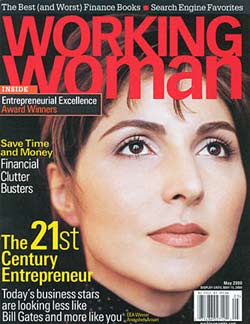 Read the detailed story from CBS News. If you like, have a look at the Anousheh Ansari's page in Wikipedia. There you can find some interesting links to her personal blog, and also to the news of her achievements that are published in various websites.
Read the detailed story from CBS News. If you like, have a look at the Anousheh Ansari's page in Wikipedia. There you can find some interesting links to her personal blog, and also to the news of her achievements that are published in various websites.
* Also available in Persian language
 ..... and the first Persian astronaut!
..... and the first Persian astronaut!This is something to be proud of. Anousheh Ansari will be the first Persian astronaut, and the first female space tourist. On 14th of September this year, she will go for a 10 days trip to the space, together with two other astronauts from Russia and the US. Before her, two Americans and one South African person have done such a trip as space tourists.
Anousheh Ansari, who is a Persian Azeri (Turk), is born in Tehran and immigrated to the US when she was 16. She received her master's degree in electrical engineering and computer science at George Washington University. She is a co-founder of Telecom Technologies, Inc. (TTI), which she sold later. Anousheh was listed in Fortune magazine's "40 under 40" list in 2001 and honored by Working Woman magazine as the winner of the 2000 National Entrepreneurial Excellence award.
Two years ago, along with her brother-in-law Amir Ansari, she made a multi-million dollar contribution to the X-Prize foundation. The X-Prize was officially renamed the Ansari X Prize in honour of their donation.
 Read the detailed story from CBS News. If you like, have a look at the Anousheh Ansari's page in Wikipedia. There you can find some interesting links to her personal blog, and also to the news of her achievements that are published in various websites.
Read the detailed story from CBS News. If you like, have a look at the Anousheh Ansari's page in Wikipedia. There you can find some interesting links to her personal blog, and also to the news of her achievements that are published in various websites.Labels: Astronomy, Persian heritage
Goodbye Pluto!
 About 10 days ago, I wrote about the meeting of the International Astronomical Union (IAU) in Prague for deciding Pluto fate. I predicted that we will end up with a solar system with only eight planets, and Pluto will not be consider an official planet anymore.
About 10 days ago, I wrote about the meeting of the International Astronomical Union (IAU) in Prague for deciding Pluto fate. I predicted that we will end up with a solar system with only eight planets, and Pluto will not be consider an official planet anymore.
Well, I read today that my prediction came true! Pluto is now a "dwarf planet." Apparently some people disagree with this decision, but to my point of view this is they way it should be. Our solar system has only eight planets, and there are two astroid belts. You can read detailed news from The New York Times, or from BBC.
* Also available in Persian language
 About 10 days ago, I wrote about the meeting of the International Astronomical Union (IAU) in Prague for deciding Pluto fate. I predicted that we will end up with a solar system with only eight planets, and Pluto will not be consider an official planet anymore.
About 10 days ago, I wrote about the meeting of the International Astronomical Union (IAU) in Prague for deciding Pluto fate. I predicted that we will end up with a solar system with only eight planets, and Pluto will not be consider an official planet anymore.Well, I read today that my prediction came true! Pluto is now a "dwarf planet." Apparently some people disagree with this decision, but to my point of view this is they way it should be. Our solar system has only eight planets, and there are two astroid belts. You can read detailed news from The New York Times, or from BBC.
Labels: Astronomy
Friday, August 25, 2006
The second Persian Empire (2): Sassanid
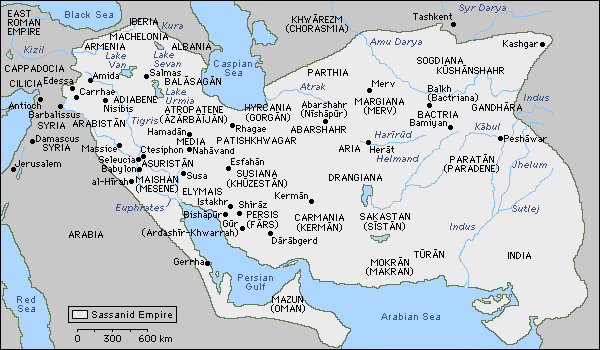 I hope you still remember the story of the Parthian Persian Empire that I told you. Here is the rest of the second Persian Empire: the Sassanids, as I promised.
I hope you still remember the story of the Parthian Persian Empire that I told you. Here is the rest of the second Persian Empire: the Sassanids, as I promised.
In the year 226, "Ardashir I" brought 500 year-old Parthian Empire to an end and began four centuries of Sassanid rule (until the year 651). This incredible achievement of Ardeshir I is carved in stone in Naqsh-e Rostam (near Persepolis, the famous capital of the first Persian Empire) . There you can see Ahuramazda, the supreme god, handing over the ring of power to Ardashir I. The religion of Persians was Zoroastrianism at that time (before the invasion of Arabs that introduced Islam to Persia). In fact, the lasting heritage of the Sassanid Persian Empire is the Avesta, the holy book of the prophet Zarathustra.
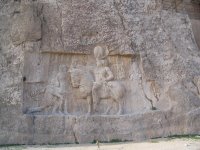 Second Persian Empire coexisted with Roman Empire, and there were great battles between them. Many of the victories of Persians is carved in stone. An example is the triumph relief of Shapur I (241-272), the most famous Sassanid rock relief. It is also located in Naqsh-e Rostam, very close to the tomb of Darius I the Great. It shows how he has defeated two Roman emperors: Emperor Valerian and Philippus Arabs. You can also find Sassanid reliefs in many other places of Persia, such as Bishapur, Taq-e Bostan, Naqsh-e Rajab, and Firuzabad. An amazing characteristic of those reliefs is that they are individualistic: the kings can be identified by their crowns. For more detailed information, please look at the LIVUS website, the page about Sassanid rock reliefs.
Second Persian Empire coexisted with Roman Empire, and there were great battles between them. Many of the victories of Persians is carved in stone. An example is the triumph relief of Shapur I (241-272), the most famous Sassanid rock relief. It is also located in Naqsh-e Rostam, very close to the tomb of Darius I the Great. It shows how he has defeated two Roman emperors: Emperor Valerian and Philippus Arabs. You can also find Sassanid reliefs in many other places of Persia, such as Bishapur, Taq-e Bostan, Naqsh-e Rajab, and Firuzabad. An amazing characteristic of those reliefs is that they are individualistic: the kings can be identified by their crowns. For more detailed information, please look at the LIVUS website, the page about Sassanid rock reliefs.
I should not forget to say something about Bisotun. It's a city in the west side of Persia, which contains very interesting features from all the Persian Empires. This year (2006), Bisotun is inscribed in the list of UNESCO World Heritage.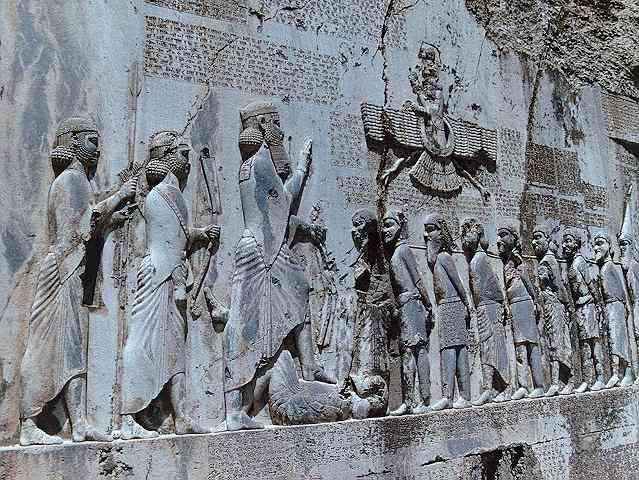 The most famous feature is the Bisotun Inscription, related to Darius the Great (the second king of the first Persian Empire). It is engraved on a cliff about 100 meters off the ground, and below and around it there are ca. 1,200 lines of inscriptions. It tells the story of the battles Darius waged in 521-520 BC against the governors who attempted to take apart the Empire founded by Cyrus (the first king). The inscription is written in three languages: the oldest is an Elamite text, followed by a Babylonian version and an Old Persian version of similar legends. This document is most crucial in the decipherment of a previously lost script. To Old Persian language, it is what the Rosetta Stone is to Egyptian hieroglyphs.
The most famous feature is the Bisotun Inscription, related to Darius the Great (the second king of the first Persian Empire). It is engraved on a cliff about 100 meters off the ground, and below and around it there are ca. 1,200 lines of inscriptions. It tells the story of the battles Darius waged in 521-520 BC against the governors who attempted to take apart the Empire founded by Cyrus (the first king). The inscription is written in three languages: the oldest is an Elamite text, followed by a Babylonian version and an Old Persian version of similar legends. This document is most crucial in the decipherment of a previously lost script. To Old Persian language, it is what the Rosetta Stone is to Egyptian hieroglyphs.
Bisotun was also an important place during the second Persian Empire. There are several rock reliefs there from both the Parthian and the Sassanids. It is no coincidence that the scene of the sad story about the star-crossed lovers Shirin and Farhad and Shirin's husband, the Sassanid king Khusrau II (590-628), is laid at Bisotun.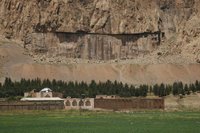 Khusrau II is also connected to the last known monument at Bisotun: The unfinished relief. His armies had captured Syria, Jerusalem in 614, Egypt and even reached Constantinople. It seemed as if the Achaemenid empire was restored, and Khusrau ordered the making of brilliant rock reliefs at Taq-e Bostan and Behistun. The monument at Taq-e Bostan was finished, but the Behistun relief was not: all that is visible is a piece of rock that was cleared.
Khusrau II is also connected to the last known monument at Bisotun: The unfinished relief. His armies had captured Syria, Jerusalem in 614, Egypt and even reached Constantinople. It seemed as if the Achaemenid empire was restored, and Khusrau ordered the making of brilliant rock reliefs at Taq-e Bostan and Behistun. The monument at Taq-e Bostan was finished, but the Behistun relief was not: all that is visible is a piece of rock that was cleared.
The capital city of the second Persian Empire was Ctesiphon (also known as "Tisfun", or in arabic "Madain"). The legendary architecture of that city, the Great Arch (Ayvan-e Madain, Taq-e Khusrau, Taq-e Kasra), still exists but is in danger. It is not yet registered in the UNESCO World Heritage. The arch is located in what is now the Iraqi town of Salman Pak (formerly, Madain), just to the south of the capital, Baghdad. I hope in near future the new government of Iraq do some effort to restore this extraordinary structure.
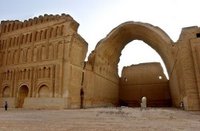
The last king of the second Persian Empire was Yazdgard III, whose reign began in 632. In 636, the Arabs took Ctesiphon, in 641, they invaded Persia (battle of Nehavand), and ten years later, the last Sassanid king died as a fugitive.
 I hope you still remember the story of the Parthian Persian Empire that I told you. Here is the rest of the second Persian Empire: the Sassanids, as I promised.
I hope you still remember the story of the Parthian Persian Empire that I told you. Here is the rest of the second Persian Empire: the Sassanids, as I promised.In the year 226, "Ardashir I" brought 500 year-old Parthian Empire to an end and began four centuries of Sassanid rule (until the year 651). This incredible achievement of Ardeshir I is carved in stone in Naqsh-e Rostam (near Persepolis, the famous capital of the first Persian Empire) . There you can see Ahuramazda, the supreme god, handing over the ring of power to Ardashir I. The religion of Persians was Zoroastrianism at that time (before the invasion of Arabs that introduced Islam to Persia). In fact, the lasting heritage of the Sassanid Persian Empire is the Avesta, the holy book of the prophet Zarathustra.
 Second Persian Empire coexisted with Roman Empire, and there were great battles between them. Many of the victories of Persians is carved in stone. An example is the triumph relief of Shapur I (241-272), the most famous Sassanid rock relief. It is also located in Naqsh-e Rostam, very close to the tomb of Darius I the Great. It shows how he has defeated two Roman emperors: Emperor Valerian and Philippus Arabs. You can also find Sassanid reliefs in many other places of Persia, such as Bishapur, Taq-e Bostan, Naqsh-e Rajab, and Firuzabad. An amazing characteristic of those reliefs is that they are individualistic: the kings can be identified by their crowns. For more detailed information, please look at the LIVUS website, the page about Sassanid rock reliefs.
Second Persian Empire coexisted with Roman Empire, and there were great battles between them. Many of the victories of Persians is carved in stone. An example is the triumph relief of Shapur I (241-272), the most famous Sassanid rock relief. It is also located in Naqsh-e Rostam, very close to the tomb of Darius I the Great. It shows how he has defeated two Roman emperors: Emperor Valerian and Philippus Arabs. You can also find Sassanid reliefs in many other places of Persia, such as Bishapur, Taq-e Bostan, Naqsh-e Rajab, and Firuzabad. An amazing characteristic of those reliefs is that they are individualistic: the kings can be identified by their crowns. For more detailed information, please look at the LIVUS website, the page about Sassanid rock reliefs.I should not forget to say something about Bisotun. It's a city in the west side of Persia, which contains very interesting features from all the Persian Empires. This year (2006), Bisotun is inscribed in the list of UNESCO World Heritage.
 The most famous feature is the Bisotun Inscription, related to Darius the Great (the second king of the first Persian Empire). It is engraved on a cliff about 100 meters off the ground, and below and around it there are ca. 1,200 lines of inscriptions. It tells the story of the battles Darius waged in 521-520 BC against the governors who attempted to take apart the Empire founded by Cyrus (the first king). The inscription is written in three languages: the oldest is an Elamite text, followed by a Babylonian version and an Old Persian version of similar legends. This document is most crucial in the decipherment of a previously lost script. To Old Persian language, it is what the Rosetta Stone is to Egyptian hieroglyphs.
The most famous feature is the Bisotun Inscription, related to Darius the Great (the second king of the first Persian Empire). It is engraved on a cliff about 100 meters off the ground, and below and around it there are ca. 1,200 lines of inscriptions. It tells the story of the battles Darius waged in 521-520 BC against the governors who attempted to take apart the Empire founded by Cyrus (the first king). The inscription is written in three languages: the oldest is an Elamite text, followed by a Babylonian version and an Old Persian version of similar legends. This document is most crucial in the decipherment of a previously lost script. To Old Persian language, it is what the Rosetta Stone is to Egyptian hieroglyphs.Bisotun was also an important place during the second Persian Empire. There are several rock reliefs there from both the Parthian and the Sassanids. It is no coincidence that the scene of the sad story about the star-crossed lovers Shirin and Farhad and Shirin's husband, the Sassanid king Khusrau II (590-628), is laid at Bisotun.
 Khusrau II is also connected to the last known monument at Bisotun: The unfinished relief. His armies had captured Syria, Jerusalem in 614, Egypt and even reached Constantinople. It seemed as if the Achaemenid empire was restored, and Khusrau ordered the making of brilliant rock reliefs at Taq-e Bostan and Behistun. The monument at Taq-e Bostan was finished, but the Behistun relief was not: all that is visible is a piece of rock that was cleared.
Khusrau II is also connected to the last known monument at Bisotun: The unfinished relief. His armies had captured Syria, Jerusalem in 614, Egypt and even reached Constantinople. It seemed as if the Achaemenid empire was restored, and Khusrau ordered the making of brilliant rock reliefs at Taq-e Bostan and Behistun. The monument at Taq-e Bostan was finished, but the Behistun relief was not: all that is visible is a piece of rock that was cleared.The capital city of the second Persian Empire was Ctesiphon (also known as "Tisfun", or in arabic "Madain"). The legendary architecture of that city, the Great Arch (Ayvan-e Madain, Taq-e Khusrau, Taq-e Kasra), still exists but is in danger. It is not yet registered in the UNESCO World Heritage. The arch is located in what is now the Iraqi town of Salman Pak (formerly, Madain), just to the south of the capital, Baghdad. I hope in near future the new government of Iraq do some effort to restore this extraordinary structure.

The last king of the second Persian Empire was Yazdgard III, whose reign began in 632. In 636, the Arabs took Ctesiphon, in 641, they invaded Persia (battle of Nehavand), and ten years later, the last Sassanid king died as a fugitive.
Labels: Art, Persian heritage, Persian history
Wednesday, August 23, 2006
Persian democracy
One hundred years ago in these days, the king of Persia (Mozzafar al-Din Shah Qajar, 1853 – 1907) accepted to create a parliament, by which the monarch's power was curtailed as he granted a constitution and parliament to the people. He died of a heart attack 40 days after granting this constitution, and his successor (Mohammad Ali Shah Qajar, 1872 - 1925) was against that decision. He dissolved the parliament with the military and political support of Russia and Britain.
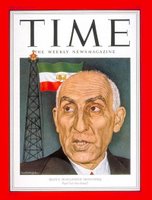 The political movements that came later resulted in the dissolution of the Qajar dynasty in 1925 and the ascension of Reza Shah Pahlavi (1878 - 1944) to the throne, and left the power totally in hands of the new king. It changed, however, in early 1950's when Dr. Mohammad Mossadegh (1882 - 1967) became the democratic elected prime minister. It was at the time of Mohammad Reza Shah Pahlavi (1919 - 1980), the last king of Persia. Mossadegh had a Doctorate in Law from the University of Lausanne in Switzerland. His government was the only democratic period in contemporary Persian history.
The political movements that came later resulted in the dissolution of the Qajar dynasty in 1925 and the ascension of Reza Shah Pahlavi (1878 - 1944) to the throne, and left the power totally in hands of the new king. It changed, however, in early 1950's when Dr. Mohammad Mossadegh (1882 - 1967) became the democratic elected prime minister. It was at the time of Mohammad Reza Shah Pahlavi (1919 - 1980), the last king of Persia. Mossadegh had a Doctorate in Law from the University of Lausanne in Switzerland. His government was the only democratic period in contemporary Persian history.
The main challenge of Dr. Mossadegh was with the British government about the oil. Till that date, Britain was just taking the oil from Persia and not really paying for that. Dr. Mossadegh announced the oil a "national resource" and proposed to sell it to Britain, instead of letting them just take it. Britain made a case against Dr. Mossadegh's government (The Anglo-Iranian Oil Company case) in the International Court of Justice. Dr. Mossadegh, himself, defended the case in the court, and won that case!
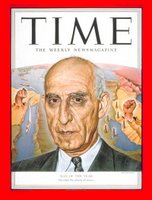 The sad story starts here. The British government did not accept the fact that a democratic government in Persia makes a decision for its own country, which could be against the benefit of Britain. They decided to remove Dr. Mossadegh from power, but they needed the help and support of the US government. Harry Truman did not agree with the idea of Winston Churchill, but as soon as Dwight Eisenhower got the power, in early 1953, the CIA and SIS started the plan.
The sad story starts here. The British government did not accept the fact that a democratic government in Persia makes a decision for its own country, which could be against the benefit of Britain. They decided to remove Dr. Mossadegh from power, but they needed the help and support of the US government. Harry Truman did not agree with the idea of Winston Churchill, but as soon as Dwight Eisenhower got the power, in early 1953, the CIA and SIS started the plan.
In 19 August 1953, Dr. Mossadegh was removed from power by a complex military coup known as Operation Ajax (New York Times, in 2000, published the CIA documents about this operation). Dr. Mossadegh was tried by a military tribunal for high treason and received a sentence of 3 years in solitary confinement, at a military jail, and was exiled to his village, not far from Tehran, where he remained under house arrest until his death, on 5 March 1967.
I think not only the fate of democracy in Persia, but also the historic path of the whole Middle East would be different if the Britain and the US governments thought a bit further than their short time benefits. I wish the US government that wants to give democracy to the Middle East now, did not take it away from Persia 53 years ago. It's my personal idea, but it is interesting to hear the exact same thing from Bill Clinton, the former US president! Last year, in an interview with Charlie Rose during World Economic Forum held in Davos, Switzerland, Bill Clinton said:
.... Iran's a whole different kettle of fish, but.. It's a sad story that really began in the 1950s when the United States deposed Mr. Mossadegh, who was an elected parliamentary democrat, and brought the Shah back in. And then he was overthrown by the Ayatollah Khomeini, driving us in the arms of Saddam Hossein! The most of the terrible things that Saddam Hossein did in 1980's, he did with the full knowing and support of the United States government. Because he was in Iran, and Iran was what it was because we got rid of their parliamentary democracy back in the 50's. At least that is my believe. I know it is not popular for an American ever to say anything like this, but I think it's true, and I apologized when President Khatami was elected. I publicly acknowledged that the United States had actively overthrown Mossadegh and I apologized for it, and I hope that we could have some rapprochement with Iran....
The video of this interview was available on the Internet, but not any more! You can still read part of that interview here.
 The political movements that came later resulted in the dissolution of the Qajar dynasty in 1925 and the ascension of Reza Shah Pahlavi (1878 - 1944) to the throne, and left the power totally in hands of the new king. It changed, however, in early 1950's when Dr. Mohammad Mossadegh (1882 - 1967) became the democratic elected prime minister. It was at the time of Mohammad Reza Shah Pahlavi (1919 - 1980), the last king of Persia. Mossadegh had a Doctorate in Law from the University of Lausanne in Switzerland. His government was the only democratic period in contemporary Persian history.
The political movements that came later resulted in the dissolution of the Qajar dynasty in 1925 and the ascension of Reza Shah Pahlavi (1878 - 1944) to the throne, and left the power totally in hands of the new king. It changed, however, in early 1950's when Dr. Mohammad Mossadegh (1882 - 1967) became the democratic elected prime minister. It was at the time of Mohammad Reza Shah Pahlavi (1919 - 1980), the last king of Persia. Mossadegh had a Doctorate in Law from the University of Lausanne in Switzerland. His government was the only democratic period in contemporary Persian history.The main challenge of Dr. Mossadegh was with the British government about the oil. Till that date, Britain was just taking the oil from Persia and not really paying for that. Dr. Mossadegh announced the oil a "national resource" and proposed to sell it to Britain, instead of letting them just take it. Britain made a case against Dr. Mossadegh's government (The Anglo-Iranian Oil Company case) in the International Court of Justice. Dr. Mossadegh, himself, defended the case in the court, and won that case!
 The sad story starts here. The British government did not accept the fact that a democratic government in Persia makes a decision for its own country, which could be against the benefit of Britain. They decided to remove Dr. Mossadegh from power, but they needed the help and support of the US government. Harry Truman did not agree with the idea of Winston Churchill, but as soon as Dwight Eisenhower got the power, in early 1953, the CIA and SIS started the plan.
The sad story starts here. The British government did not accept the fact that a democratic government in Persia makes a decision for its own country, which could be against the benefit of Britain. They decided to remove Dr. Mossadegh from power, but they needed the help and support of the US government. Harry Truman did not agree with the idea of Winston Churchill, but as soon as Dwight Eisenhower got the power, in early 1953, the CIA and SIS started the plan.In 19 August 1953, Dr. Mossadegh was removed from power by a complex military coup known as Operation Ajax (New York Times, in 2000, published the CIA documents about this operation). Dr. Mossadegh was tried by a military tribunal for high treason and received a sentence of 3 years in solitary confinement, at a military jail, and was exiled to his village, not far from Tehran, where he remained under house arrest until his death, on 5 March 1967.
I think not only the fate of democracy in Persia, but also the historic path of the whole Middle East would be different if the Britain and the US governments thought a bit further than their short time benefits. I wish the US government that wants to give democracy to the Middle East now, did not take it away from Persia 53 years ago. It's my personal idea, but it is interesting to hear the exact same thing from Bill Clinton, the former US president! Last year, in an interview with Charlie Rose during World Economic Forum held in Davos, Switzerland, Bill Clinton said:
.... Iran's a whole different kettle of fish, but.. It's a sad story that really began in the 1950s when the United States deposed Mr. Mossadegh, who was an elected parliamentary democrat, and brought the Shah back in. And then he was overthrown by the Ayatollah Khomeini, driving us in the arms of Saddam Hossein! The most of the terrible things that Saddam Hossein did in 1980's, he did with the full knowing and support of the United States government. Because he was in Iran, and Iran was what it was because we got rid of their parliamentary democracy back in the 50's. At least that is my believe. I know it is not popular for an American ever to say anything like this, but I think it's true, and I apologized when President Khatami was elected. I publicly acknowledged that the United States had actively overthrown Mossadegh and I apologized for it, and I hope that we could have some rapprochement with Iran....
The video of this interview was available on the Internet, but not any more! You can still read part of that interview here.
Labels: Persian history
Monday, August 21, 2006
Exhibiton of Persian Empires in Japan
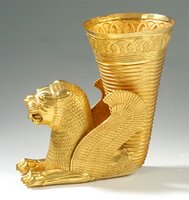
Persian Civilization: 7000 Years of Treasures
Venue: Tokyo Metropolitan Art Museum
Schedule: From 2006-08-01 To 2006-10-01
Address: 8-36 Ueno Park, Taito-ku, Tokyo 110-8712
Phone: 03-3823-6921 Fax: 03-3823-6920
This exhibition includes fascinating articles from both the first (Achaemenid) and the second (Sassanid) Persian Empires. At the end of this exhibition, the collection will also be presented in Korea, and most probably in the Palace Museum, China, as reported by the Cultural Heritage News Agency (the report is in Persian language).

Persian Civilization: 7000 Years of Treasures
Venue: Tokyo Metropolitan Art Museum
Schedule: From 2006-08-01 To 2006-10-01
Address: 8-36 Ueno Park, Taito-ku, Tokyo 110-8712
Phone: 03-3823-6921 Fax: 03-3823-6920
This exhibition includes fascinating articles from both the first (Achaemenid) and the second (Sassanid) Persian Empires. At the end of this exhibition, the collection will also be presented in Korea, and most probably in the Palace Museum, China, as reported by the Cultural Heritage News Agency (the report is in Persian language).
Labels: Art, Persian heritage, Persian history
Friday, August 18, 2006
Reza Abedini and Prince Claus Award
 Prince Claus (1926 - 2002) was a German-born aristocrat who became the husband of Queen Beatrix of the Netherlands. The Prince Claus Fund, which is named after him, aims at increasing cultural awareness and promoting exchange between culture and development. Since 1997 the Prince Claus Awards are presented annually to outstanding artists, thinkers and cultural organisations.
Prince Claus (1926 - 2002) was a German-born aristocrat who became the husband of Queen Beatrix of the Netherlands. The Prince Claus Fund, which is named after him, aims at increasing cultural awareness and promoting exchange between culture and development. Since 1997 the Prince Claus Awards are presented annually to outstanding artists, thinkers and cultural organisations.
It is announced today that the Persian graphic designer Reza Abedini (1967, Tehran) will be presented with this year’s Principal Prince Claus Award of €100,000. The ceremoney will be held on Wednesday, 13 December 2006, at the Muziekgebouw aan ‘t IJ in Amsterdam. Here is what Prince Claus Fund says about him:
Reza Abedini, Principal Prince Claus Laureate
Reza Abedini is a graphic designer and a professor of graphic design and visual culture at Tehran University. He emphasises the relationship between visual tradition and modern form, encourages research in the long and rich history of Persian art and calligraphy, and nurtures talent in the younger generations. Reza Abedini is granted the Principal Prince Claus Award in recognition of his personal creativity in producing superb graphic design and his individual skill in adapting the knowledge and achievements of Iran’s [Persia's] artistic heritage, making it new and compelling today. The award values and draws attention to the diversity of Iranian [Persian] culture – both historic and contemporary. It recognises the impact of graphic design as a powerful global medium of communication, and highlights the tradition and role of graphic design both in the laureate’s own country and across the world.
* Also available in Persian language
 Prince Claus (1926 - 2002) was a German-born aristocrat who became the husband of Queen Beatrix of the Netherlands. The Prince Claus Fund, which is named after him, aims at increasing cultural awareness and promoting exchange between culture and development. Since 1997 the Prince Claus Awards are presented annually to outstanding artists, thinkers and cultural organisations.
Prince Claus (1926 - 2002) was a German-born aristocrat who became the husband of Queen Beatrix of the Netherlands. The Prince Claus Fund, which is named after him, aims at increasing cultural awareness and promoting exchange between culture and development. Since 1997 the Prince Claus Awards are presented annually to outstanding artists, thinkers and cultural organisations.It is announced today that the Persian graphic designer Reza Abedini (1967, Tehran) will be presented with this year’s Principal Prince Claus Award of €100,000. The ceremoney will be held on Wednesday, 13 December 2006, at the Muziekgebouw aan ‘t IJ in Amsterdam. Here is what Prince Claus Fund says about him:
Reza Abedini, Principal Prince Claus Laureate
Reza Abedini is a graphic designer and a professor of graphic design and visual culture at Tehran University. He emphasises the relationship between visual tradition and modern form, encourages research in the long and rich history of Persian art and calligraphy, and nurtures talent in the younger generations. Reza Abedini is granted the Principal Prince Claus Award in recognition of his personal creativity in producing superb graphic design and his individual skill in adapting the knowledge and achievements of Iran’s [Persia's] artistic heritage, making it new and compelling today. The award values and draws attention to the diversity of Iranian [Persian] culture – both historic and contemporary. It recognises the impact of graphic design as a powerful global medium of communication, and highlights the tradition and role of graphic design both in the laureate’s own country and across the world.
Labels: Art, Persian heritage
Tuesday, August 15, 2006
Deciding Pluto fate
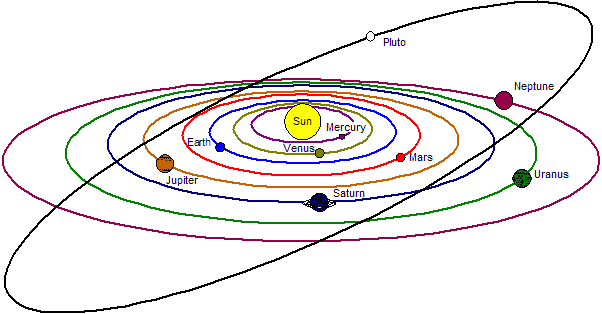 A few weeks ago there was a program in Discovery channel about the solar system and its planets. Pluto, which we knew it as a planet for more than 70 years, is not alone. Just like the astroid belt that exists between Mars and Jupiter, there is another astroid belt after Neptune, and Pluto is just one of those astroids! If Pluto was the largest astroids, the problem was not so serious. The point is that another astroid in that belt is discovered, which is larger than Pluto.
A few weeks ago there was a program in Discovery channel about the solar system and its planets. Pluto, which we knew it as a planet for more than 70 years, is not alone. Just like the astroid belt that exists between Mars and Jupiter, there is another astroid belt after Neptune, and Pluto is just one of those astroids! If Pluto was the largest astroids, the problem was not so serious. The point is that another astroid in that belt is discovered, which is larger than Pluto.
Now if we want to define a planet based on its size, we should consider the astroid larger than Pluto also a planet. Another option is to remove the name of Pluto from the list of planets of the solar system. Such a problem had also happened for the astroid belt between Mars and Jupiter. Astronomers had listed four planets in that region, which later were removed from the list and all included in the astroid belt.
Next week (21 August 2006), for 12 days, there is a conference in Prague, the capital city of Czech Republic. Astronomers are going to agree on definition of "planet," and decide on Pluto fate. I predict to have a solar system with only 8 planets and two astroid belts.
Read the detailed news in BBC.
* Also available in Persian language
 A few weeks ago there was a program in Discovery channel about the solar system and its planets. Pluto, which we knew it as a planet for more than 70 years, is not alone. Just like the astroid belt that exists between Mars and Jupiter, there is another astroid belt after Neptune, and Pluto is just one of those astroids! If Pluto was the largest astroids, the problem was not so serious. The point is that another astroid in that belt is discovered, which is larger than Pluto.
A few weeks ago there was a program in Discovery channel about the solar system and its planets. Pluto, which we knew it as a planet for more than 70 years, is not alone. Just like the astroid belt that exists between Mars and Jupiter, there is another astroid belt after Neptune, and Pluto is just one of those astroids! If Pluto was the largest astroids, the problem was not so serious. The point is that another astroid in that belt is discovered, which is larger than Pluto.Now if we want to define a planet based on its size, we should consider the astroid larger than Pluto also a planet. Another option is to remove the name of Pluto from the list of planets of the solar system. Such a problem had also happened for the astroid belt between Mars and Jupiter. Astronomers had listed four planets in that region, which later were removed from the list and all included in the astroid belt.
Next week (21 August 2006), for 12 days, there is a conference in Prague, the capital city of Czech Republic. Astronomers are going to agree on definition of "planet," and decide on Pluto fate. I predict to have a solar system with only 8 planets and two astroid belts.
Read the detailed news in BBC.
Labels: Astronomy
Sunday, August 13, 2006
Ancient Persia in Köln, 2nd Persian Empire in Paris
 Ancient Persia in Köln
Ancient Persia in Köln
Since 2 May until the end of this week (20 August 2006), there is a beautiful photo exhibition in Galerie Karsten Greve, Cologne (Köln), Germany. The exhibition called "Ancient Persia," and the photo's are from Lynn Davis, a famous American photographer. She travelled to Persia in 2001 purposefully to make these photo's!
2nd Persian Empire in Paris
An exhibition will open in Cernuschi Museum, Paris, about Sassanid Persian Empire (the second Persian Empire). The exhibition calls "The Sassanides Persians, Record of a forgotten empire," and will open from 15 September till 30 December 2006.
It is very exciting to have this exhibiton following the exhibition in the British Museum about Achaemenid Persian Empire (the first Persian Empire). Interestingly, that exhibition also called "Forgotten Empire: the world of Ancient Persia." I wrote about my visit to the British Museum in one of my previous posts: "Persian Empire in British Museum."
The series of posts that I started about the three Persian Empires is not yet complete. I wrote about the first one (Achaemenid Persian Empire), and only part of the second one (Parthian Persian Empire). Before the exhibition in Cernuschi Museum starts, I will complete my post about the second Empire (Sassanid Persian Empire), and later, I'll tell you about the third Empire (Safavid Persian Empire).
* Also available in Persian language
 Ancient Persia in Köln
Ancient Persia in KölnSince 2 May until the end of this week (20 August 2006), there is a beautiful photo exhibition in Galerie Karsten Greve, Cologne (Köln), Germany. The exhibition called "Ancient Persia," and the photo's are from Lynn Davis, a famous American photographer. She travelled to Persia in 2001 purposefully to make these photo's!
2nd Persian Empire in Paris
An exhibition will open in Cernuschi Museum, Paris, about Sassanid Persian Empire (the second Persian Empire). The exhibition calls "The Sassanides Persians, Record of a forgotten empire," and will open from 15 September till 30 December 2006.
It is very exciting to have this exhibiton following the exhibition in the British Museum about Achaemenid Persian Empire (the first Persian Empire). Interestingly, that exhibition also called "Forgotten Empire: the world of Ancient Persia." I wrote about my visit to the British Museum in one of my previous posts: "Persian Empire in British Museum."
The series of posts that I started about the three Persian Empires is not yet complete. I wrote about the first one (Achaemenid Persian Empire), and only part of the second one (Parthian Persian Empire). Before the exhibition in Cernuschi Museum starts, I will complete my post about the second Empire (Sassanid Persian Empire), and later, I'll tell you about the third Empire (Safavid Persian Empire).
Labels: Art, Persian heritage, Persian history
Saturday, August 12, 2006
Persian Leopard
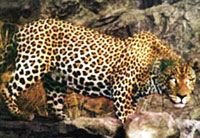 My posts in Persian and in English are not always about the same topic. It's mainly due to the fact that many of my posts in Persian are about Persian poetry, which is difficult to translate, or about the contemporary history that is not very well known for the international audience. Sometimes, however, there are topics that I think they would be of interest for everybody. Here is one of them about filming a "Persian Leopard."
My posts in Persian and in English are not always about the same topic. It's mainly due to the fact that many of my posts in Persian are about Persian poetry, which is difficult to translate, or about the contemporary history that is not very well known for the international audience. Sometimes, however, there are topics that I think they would be of interest for everybody. Here is one of them about filming a "Persian Leopard."
It is very difficult to make films or photos from the Persian wild nature, since the animals are generally frightened from humans, much more than what we see in Canada or Africa. In fact in the last 11 years nobody could make a good quality film or photo from a Persian leopard. Recently, however, a group of Persian film makers, who are filming Persian nature for UNESCO, could capture a film of this beautiful animal for 10 minutes in day light.
The scientific name of Persian Leopard is "Panthera pardus saxicolor." This animal is listed in the IUCN List of Threatened Species. There are also two other kind of leopards in Persia: "Panthera pardus tulliana" and "Panthera Pardus Melanotica" (or Millardi, I am not sure). According to the Cultural Heritage News Agency, based on unofficial records, only 60 leopards exist in Persia at present.
The news about filming the Persian Leopard is in the website of Cultural Heritage News Agency (in Persian). There is another news, however, about "Telecameras to Reveal the Secret of Persian Leopard" in the English, if you like to read.
* Also available in Persian language
 My posts in Persian and in English are not always about the same topic. It's mainly due to the fact that many of my posts in Persian are about Persian poetry, which is difficult to translate, or about the contemporary history that is not very well known for the international audience. Sometimes, however, there are topics that I think they would be of interest for everybody. Here is one of them about filming a "Persian Leopard."
My posts in Persian and in English are not always about the same topic. It's mainly due to the fact that many of my posts in Persian are about Persian poetry, which is difficult to translate, or about the contemporary history that is not very well known for the international audience. Sometimes, however, there are topics that I think they would be of interest for everybody. Here is one of them about filming a "Persian Leopard."It is very difficult to make films or photos from the Persian wild nature, since the animals are generally frightened from humans, much more than what we see in Canada or Africa. In fact in the last 11 years nobody could make a good quality film or photo from a Persian leopard. Recently, however, a group of Persian film makers, who are filming Persian nature for UNESCO, could capture a film of this beautiful animal for 10 minutes in day light.
The scientific name of Persian Leopard is "Panthera pardus saxicolor." This animal is listed in the IUCN List of Threatened Species. There are also two other kind of leopards in Persia: "Panthera pardus tulliana" and "Panthera Pardus Melanotica" (or Millardi, I am not sure). According to the Cultural Heritage News Agency, based on unofficial records, only 60 leopards exist in Persia at present.
The news about filming the Persian Leopard is in the website of Cultural Heritage News Agency (in Persian). There is another news, however, about "Telecameras to Reveal the Secret of Persian Leopard" in the English, if you like to read.
Labels: Nature, Persian heritage
Tuesday, August 08, 2006
Photosynth: Digital 3D photos!
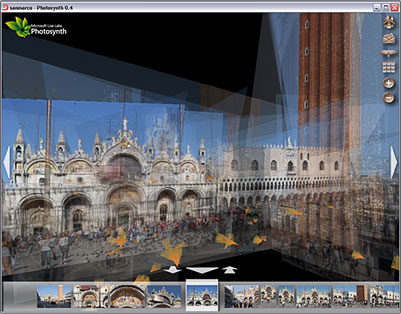 I started a series of posts about Persian history and heritage. I will continue that story, but in the meantime I don't want to ignore other interesting topics.
I started a series of posts about Persian history and heritage. I will continue that story, but in the meantime I don't want to ignore other interesting topics.
I read the article Photos transformed into 3D model in the BBC NEWS website (for those of you who are interested, here is the Persian translation of the same article). I think that's a wonderful technique. I could imagine the possibility of doing so, but I didn't expect that it come to market for public!
In short, you can have two (or more) digital photo's from the same place. The photo can even be taken in different times, using different camera's. The software will find the points that the photo's share, and creat a 3D image of the place. Isn't it wonderful? The name of the software is Photosynth.
 I started a series of posts about Persian history and heritage. I will continue that story, but in the meantime I don't want to ignore other interesting topics.
I started a series of posts about Persian history and heritage. I will continue that story, but in the meantime I don't want to ignore other interesting topics.I read the article Photos transformed into 3D model in the BBC NEWS website (for those of you who are interested, here is the Persian translation of the same article). I think that's a wonderful technique. I could imagine the possibility of doing so, but I didn't expect that it come to market for public!
In short, you can have two (or more) digital photo's from the same place. The photo can even be taken in different times, using different camera's. The software will find the points that the photo's share, and creat a 3D image of the place. Isn't it wonderful? The name of the software is Photosynth.
Labels: Art
Sunday, August 06, 2006
Update!
 I used to have Fakhredin Blog in Persian language only (فخرالدینبلاگ). During the last year, I did not update that blog very often, mainly because I wanted to make some changes in its design, and also I was thinking if running the blog only in Persian language is a wise idea.
I used to have Fakhredin Blog in Persian language only (فخرالدینبلاگ). During the last year, I did not update that blog very often, mainly because I wanted to make some changes in its design, and also I was thinking if running the blog only in Persian language is a wise idea.
As you see, a few weeks ago, I started Fakhredin Blog in English, with some new items in the design of both blogs. Now, I am updating two blogs at the same time, which is a double work.
I decided to update the blogs a bit less frequent. I definitely do not plan to update once a year! I am thinking of something like once a week or so. I hope you keep visiting my blogs and find the subjects interesting.
* Also available in Persian language
 I used to have Fakhredin Blog in Persian language only (فخرالدینبلاگ). During the last year, I did not update that blog very often, mainly because I wanted to make some changes in its design, and also I was thinking if running the blog only in Persian language is a wise idea.
I used to have Fakhredin Blog in Persian language only (فخرالدینبلاگ). During the last year, I did not update that blog very often, mainly because I wanted to make some changes in its design, and also I was thinking if running the blog only in Persian language is a wise idea.As you see, a few weeks ago, I started Fakhredin Blog in English, with some new items in the design of both blogs. Now, I am updating two blogs at the same time, which is a double work.
I decided to update the blogs a bit less frequent. I definitely do not plan to update once a year! I am thinking of something like once a week or so. I hope you keep visiting my blogs and find the subjects interesting.
Labels: General
Saturday, August 05, 2006
Articles about the name of Persian language
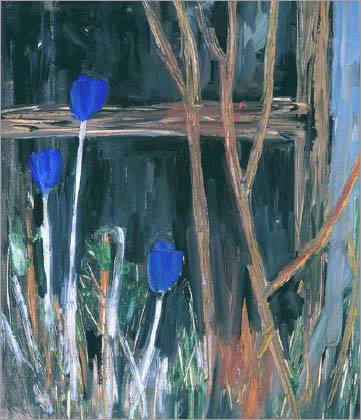 For those of you, who are interested on my post "Persian: the name of the language," I invite you to read the following articles:
For those of you, who are interested on my post "Persian: the name of the language," I invite you to read the following articles:
PS. Sohrab Sepehri (7 Oct 1928 - 21 Apr 1980), my favorite Persian poet that I introduced him in that post, was also a successful painter. He held several exhibitions all around the world. This is a photo of one of his paintings.
 For those of you, who are interested on my post "Persian: the name of the language," I invite you to read the following articles:
For those of you, who are interested on my post "Persian: the name of the language," I invite you to read the following articles:- Fársi: "recently appeared language!" by Prof. Ehsan Yarshater
- Persian or Farsi? by Dr. Kamran Talattof
PS. Sohrab Sepehri (7 Oct 1928 - 21 Apr 1980), my favorite Persian poet that I introduced him in that post, was also a successful painter. He held several exhibitions all around the world. This is a photo of one of his paintings.
Labels: Art, Persian language
Thursday, August 03, 2006
The second Persian Empire (1): Parthian
The second Persian Empire existed for about 900 years! It consists of two different dynasties; Parthian and Sassanid. I consider both dynasties together the second Persian Empire for the following reasons:
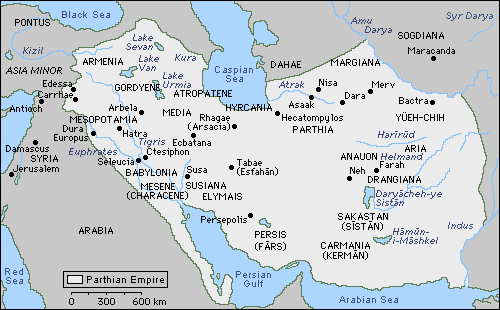
Let me say a few things about Parthian Persian Empire in this post. In the next post, I will tell you more about Sassanid Persian Empire.
The Parthians defeated Alexander the Great's successors, the Seleucids, conquered most of the Middle East and southwest Asia from about 250 B.C. until about 225 A.D. (almost five centuries!). Their capital city was Ctesiphon (Persian: تیسفون pronounce: tisfun), which also remained as the capital city of their successor, the Sassanid Persian Empire. Ctesiphon is located approximately 20 miles southeast of the modern city of Baghdad, Iraq, along the river Tigris. I will tell you more about this city when I write about the Sassanid Persian Empire.
Ctesiphon, unfortunately, is not registered in the Unesco World Heritage list yet. There are news that many destructions have happened to the remaining of this city in the last few years, with no national or international effort to prevent that. If you who read this page are in a position to talk it louder and let the world know, please do so. It is such a pity to loose a precious heritage like that so easily.
Another important city of Parthian Persian Empire is Hatra, which was later the capital of the Arab Kingdom. This city is also located in Iraq, and, fortunately, is registered in Unesco World Heritage. See a beautiful photo of Hatra here. Today Hatra, which remains mostly unexcavated, is in a very worrying state of conservation. Parts of the site have been fenced off to protect it from possible looting
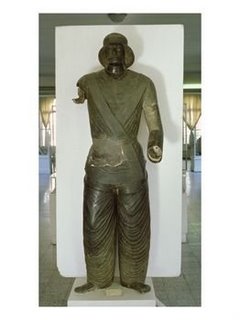
One of the most fasinating items that remained from Parthia period is the life-sized bronze statue of a Parthian prince. It has only one arm, but the rest of it is intact. This statue is so famous that it is almost impossible to talk about Parthians without mentioning that statue. It is now kept in the National Museum of Iran (Persia).
If you like to read about the second Persian Empire, the Parthians, here are some internet resources. You can, of course, find more if you search Google.
Parthian.com
Wikipedia
LIVIUS Articles on Ancient History
Iran Chamber Society
(although Iran is frequently used in this site, please remember that Persia is the better name of the country as I discussed in my previous post: Persia today).
- Both dynasties were Persian (from Persia), although Parthians had different ethnicity than Pars.
- The Parthian Persian Empire continued with the Sassanid Persian Empire. There was no invasion or destruction of the Persian Empire in between. That is different for Achaemenids Persian Empire (the first one), which ended up with the invasion of Alexander the Great, and Sassanid Persian Empire, which ended up with the invasion of Arabs.

Let me say a few things about Parthian Persian Empire in this post. In the next post, I will tell you more about Sassanid Persian Empire.
The Parthians defeated Alexander the Great's successors, the Seleucids, conquered most of the Middle East and southwest Asia from about 250 B.C. until about 225 A.D. (almost five centuries!). Their capital city was Ctesiphon (Persian: تیسفون pronounce: tisfun), which also remained as the capital city of their successor, the Sassanid Persian Empire. Ctesiphon is located approximately 20 miles southeast of the modern city of Baghdad, Iraq, along the river Tigris. I will tell you more about this city when I write about the Sassanid Persian Empire.
Ctesiphon, unfortunately, is not registered in the Unesco World Heritage list yet. There are news that many destructions have happened to the remaining of this city in the last few years, with no national or international effort to prevent that. If you who read this page are in a position to talk it louder and let the world know, please do so. It is such a pity to loose a precious heritage like that so easily.
Another important city of Parthian Persian Empire is Hatra, which was later the capital of the Arab Kingdom. This city is also located in Iraq, and, fortunately, is registered in Unesco World Heritage. See a beautiful photo of Hatra here. Today Hatra, which remains mostly unexcavated, is in a very worrying state of conservation. Parts of the site have been fenced off to protect it from possible looting

One of the most fasinating items that remained from Parthia period is the life-sized bronze statue of a Parthian prince. It has only one arm, but the rest of it is intact. This statue is so famous that it is almost impossible to talk about Parthians without mentioning that statue. It is now kept in the National Museum of Iran (Persia).
If you like to read about the second Persian Empire, the Parthians, here are some internet resources. You can, of course, find more if you search Google.
Parthian.com
Wikipedia
LIVIUS Articles on Ancient History
Iran Chamber Society
(although Iran is frequently used in this site, please remember that Persia is the better name of the country as I discussed in my previous post: Persia today).
Labels: Persian history
Wednesday, August 02, 2006
Persian Empire in British Museum
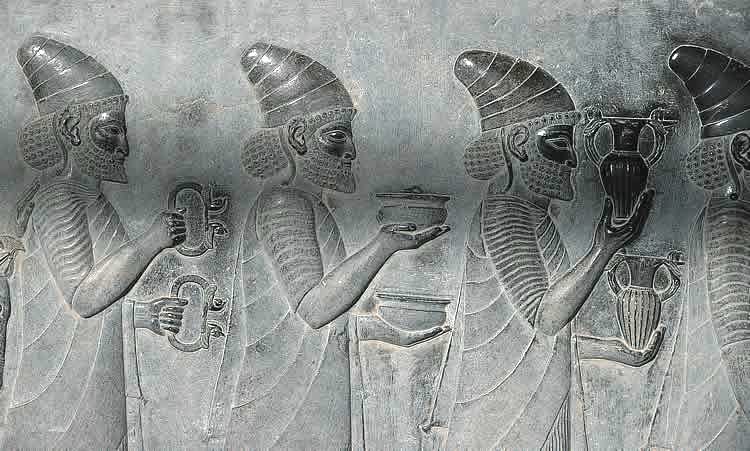 From last year September 9th till January 8th this year, there was a wonderful exhibition in the British Museum called "FORGOTTEN EMPIRE the world of Ancient Persia." I went there, just before Christmas. It was amazing! The exhibition was the largest collection ever presented from the first Persian Empire (Achaemenids). Many items were from the British Museum itself, but many were also borrowed from the Louvre, and the National Museum of Iran (Persia).
From last year September 9th till January 8th this year, there was a wonderful exhibition in the British Museum called "FORGOTTEN EMPIRE the world of Ancient Persia." I went there, just before Christmas. It was amazing! The exhibition was the largest collection ever presented from the first Persian Empire (Achaemenids). Many items were from the British Museum itself, but many were also borrowed from the Louvre, and the National Museum of Iran (Persia).
Besides the interesting old Persian texts engraved on stones, huge columns, and beautiful jewelry, I was particularly fascinated by the statue of Darius the Great, and the Cyrus Cylinder (which I wrote about it before).
Something very special that I saw in the jewelry exhibition was a pair of gold bracelets (or armlets) with leaping lion-griffins. Just by looking at them you could imagine they were possibly the most valuable bracelets in the whole world. Interestingly, you can see the same bracelets carried by Lydians on a relief from the east side of the Apadana at Persepolis (that's the photo I put here).
What I should not forget to mention is the order of the items in the exhibition. It started with the amazing statue of Darius the Great, and followed by the items about the palaces, government and people. Then you could see the luxury of Persians including items about dining, and, of course, jewelry. When you were astounded from all those impressions, you would face the destruction of the Persian Empire by Alexander the Great. But, before you started feeling sad, a small collection would tell you that Persian Empire rose again 150 years after Alexander. But that was not all! At the very end of the exhibition, you faced the Cyrus Cylinder! It was such a wonderful feeling to see that although the Persian Empire destroyed by Alexander, the message of human right from Cyrus the Great is still alive, now more than ever.
It was said that many items from the second Persian Empire (Parthian / Sassanid Empire) are among the permanent collections of British Museum. It will be nice if the items from other museums are also collected, and one can visit a comprehensive exhibition of the second Persian Empire. For the third Persian Empire (Safavid Empire), you should give a visit to Esfahan, the capital city of that Empire. Later, I will also write about Esfahan. In fact, I have a lot to tell you about it.....
 From last year September 9th till January 8th this year, there was a wonderful exhibition in the British Museum called "FORGOTTEN EMPIRE the world of Ancient Persia." I went there, just before Christmas. It was amazing! The exhibition was the largest collection ever presented from the first Persian Empire (Achaemenids). Many items were from the British Museum itself, but many were also borrowed from the Louvre, and the National Museum of Iran (Persia).
From last year September 9th till January 8th this year, there was a wonderful exhibition in the British Museum called "FORGOTTEN EMPIRE the world of Ancient Persia." I went there, just before Christmas. It was amazing! The exhibition was the largest collection ever presented from the first Persian Empire (Achaemenids). Many items were from the British Museum itself, but many were also borrowed from the Louvre, and the National Museum of Iran (Persia).Besides the interesting old Persian texts engraved on stones, huge columns, and beautiful jewelry, I was particularly fascinated by the statue of Darius the Great, and the Cyrus Cylinder (which I wrote about it before).
Something very special that I saw in the jewelry exhibition was a pair of gold bracelets (or armlets) with leaping lion-griffins. Just by looking at them you could imagine they were possibly the most valuable bracelets in the whole world. Interestingly, you can see the same bracelets carried by Lydians on a relief from the east side of the Apadana at Persepolis (that's the photo I put here).
What I should not forget to mention is the order of the items in the exhibition. It started with the amazing statue of Darius the Great, and followed by the items about the palaces, government and people. Then you could see the luxury of Persians including items about dining, and, of course, jewelry. When you were astounded from all those impressions, you would face the destruction of the Persian Empire by Alexander the Great. But, before you started feeling sad, a small collection would tell you that Persian Empire rose again 150 years after Alexander. But that was not all! At the very end of the exhibition, you faced the Cyrus Cylinder! It was such a wonderful feeling to see that although the Persian Empire destroyed by Alexander, the message of human right from Cyrus the Great is still alive, now more than ever.
It was said that many items from the second Persian Empire (Parthian / Sassanid Empire) are among the permanent collections of British Museum. It will be nice if the items from other museums are also collected, and one can visit a comprehensive exhibition of the second Persian Empire. For the third Persian Empire (Safavid Empire), you should give a visit to Esfahan, the capital city of that Empire. Later, I will also write about Esfahan. In fact, I have a lot to tell you about it.....
Labels: Art, Persian heritage, Persian history
Tuesday, August 01, 2006
The first Persian Empire: Achaemenids
Many people in the West know only about the Persian Empire that was destroyed by Alexander the Great, but few people know that Persian Empire existed for many many years even after Alexander. Let me shortly tell you the story:
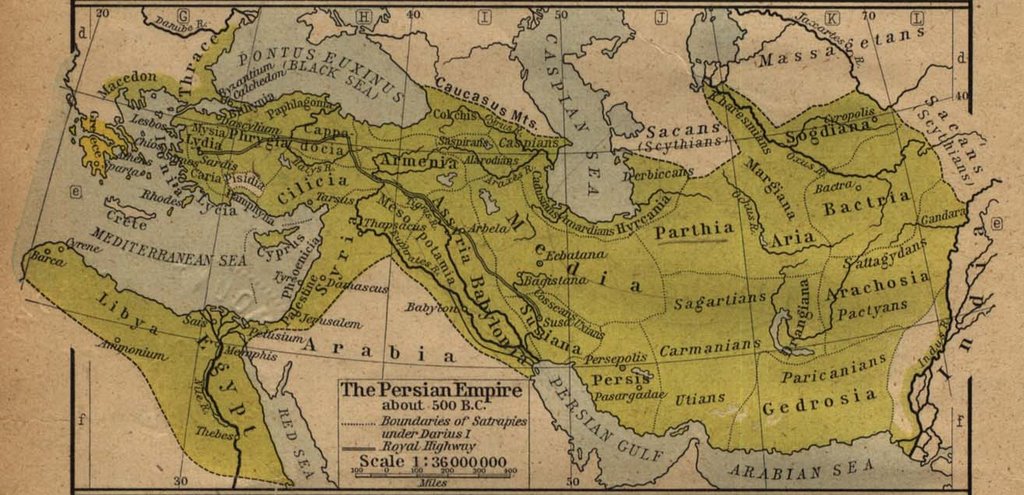 I'm sure you all know about the first Persian Empire more than 2500 years ago. The one which established by Cyrus the Great (in 648 BC) and was on its golden stage at the time of Darius the Great. Many of those Emperors are mentioned the Bible (the old testament). It was the largest and wealthiest country in the whole world. It's nice to know that the first human right was ordered by Cyrus the Great when he conquered Babylon. The story is written in details in the old testament, and its proof still exists as the Cyrus Cylinder, which is kept in the British Museum. The United Nation has announced the Cyrus Cylinder as "first charter of human rights".
I'm sure you all know about the first Persian Empire more than 2500 years ago. The one which established by Cyrus the Great (in 648 BC) and was on its golden stage at the time of Darius the Great. Many of those Emperors are mentioned the Bible (the old testament). It was the largest and wealthiest country in the whole world. It's nice to know that the first human right was ordered by Cyrus the Great when he conquered Babylon. The story is written in details in the old testament, and its proof still exists as the Cyrus Cylinder, which is kept in the British Museum. The United Nation has announced the Cyrus Cylinder as "first charter of human rights".
The first Persian Empire is called Achaemenid Empire (Persia: امپراطوری هخامنشی), and was overtaken by Alexander the Great in 330 BC. He put Persepolis (the richest city in the world at its time) on fire. Historians believe that there was no war at Persepolis. Alexander has already defeated the Persian army when he arrived to Persepolis. Actually, Persepolis was not a military site, and there were no soldiers there. Burning Persepolis was only an act of anger against the royalty of the Persian Emperors. There were also wonderful gardens of the Persians in and around Persepolis, which were destroyed by Alexander's army. The name of those gardens in Persian language was پردیس (pronounce: pærdis, or pairida za in old Persian). The word "paradise" is in fact driven from pærdis, which indicates the extreme beauty of those gardens.
za in old Persian). The word "paradise" is in fact driven from pærdis, which indicates the extreme beauty of those gardens.
After the death of Alexander, one of his generals, Seleucus I Nicator took power over Persia. The Seleucid Dynasty ruled over Persia for more than 150 years until the rise of the second Persia Empire.
There was a wonderful exhibition about Achaemenid Empire last year in the British Museum. I went there and it was a wonderful experience. I have already written about that exhibition in the Persian page of my blog (فخرالدینبلاگ). I will write about it also here before we move on together to the second and the third Persian Empires.
 I'm sure you all know about the first Persian Empire more than 2500 years ago. The one which established by Cyrus the Great (in 648 BC) and was on its golden stage at the time of Darius the Great. Many of those Emperors are mentioned the Bible (the old testament). It was the largest and wealthiest country in the whole world. It's nice to know that the first human right was ordered by Cyrus the Great when he conquered Babylon. The story is written in details in the old testament, and its proof still exists as the Cyrus Cylinder, which is kept in the British Museum. The United Nation has announced the Cyrus Cylinder as "first charter of human rights".
I'm sure you all know about the first Persian Empire more than 2500 years ago. The one which established by Cyrus the Great (in 648 BC) and was on its golden stage at the time of Darius the Great. Many of those Emperors are mentioned the Bible (the old testament). It was the largest and wealthiest country in the whole world. It's nice to know that the first human right was ordered by Cyrus the Great when he conquered Babylon. The story is written in details in the old testament, and its proof still exists as the Cyrus Cylinder, which is kept in the British Museum. The United Nation has announced the Cyrus Cylinder as "first charter of human rights".The first Persian Empire is called Achaemenid Empire (Persia: امپراطوری هخامنشی), and was overtaken by Alexander the Great in 330 BC. He put Persepolis (the richest city in the world at its time) on fire. Historians believe that there was no war at Persepolis. Alexander has already defeated the Persian army when he arrived to Persepolis. Actually, Persepolis was not a military site, and there were no soldiers there. Burning Persepolis was only an act of anger against the royalty of the Persian Emperors. There were also wonderful gardens of the Persians in and around Persepolis, which were destroyed by Alexander's army. The name of those gardens in Persian language was پردیس (pronounce: pærdis, or pairida
After the death of Alexander, one of his generals, Seleucus I Nicator took power over Persia. The Seleucid Dynasty ruled over Persia for more than 150 years until the rise of the second Persia Empire.
There was a wonderful exhibition about Achaemenid Empire last year in the British Museum. I went there and it was a wonderful experience. I have already written about that exhibition in the Persian page of my blog (فخرالدینبلاگ). I will write about it also here before we move on together to the second and the third Persian Empires.
Labels: Persian history

